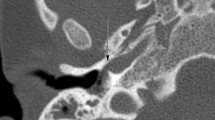Abstract
We prospectively studied 163 patients referred for MRI of the temporal bone. A presumed diagnosis was made using only one of three sequences: a single thick (12 mm) slice fast T2-sequence, 3D fourier transform constructive interference in steady state (3DFT-CISS) sequence and a gadolinium-enhanced T1-weighted sequence. The visibility of the cochlea, vestibule and superior, lateral and posterior semicircular canals of normal temporal bones was assessed on the T2-weighted images: they were almost always visible (98–100 %), with exception of the superior semicircular canal, seen in only 35 % of cases. The images were interpreted as abnormal in 34 patients (21 %). Using only the fast T2-weighted, 3DFT-CISS and gadolinium-enhanced T1-weighted sequences a presumed false positive diagnosis was made in 5, 1 and 0 cases and a false negative diagnosis in 2, 2 and 4 cases respectively. The overall reliability of the thick-section fast T2-weighted images is limited. This study suggests that a combination of gadolinium-enhanced T1-weighted and 3DFT-CISS images can be considered the gold standard for temporal bone MRI and neither sequence performed separately is as accurate as both together.
Similar content being viewed by others
Author information
Authors and Affiliations
Additional information
Received: 4 November 1997 Accepted: 17 July 1998
Rights and permissions
About this article
Cite this article
Lemmerling, M., De Praeter, G., Caemaert, J. et al. Accuracy of single-sequence MRI for investigation of the fluid-filled spaces in the inner ear and cerebellopontine angle. Neuroradiology 41, 292–299 (1999). https://doi.org/10.1007/s002340050751
Issue Date:
DOI: https://doi.org/10.1007/s002340050751




